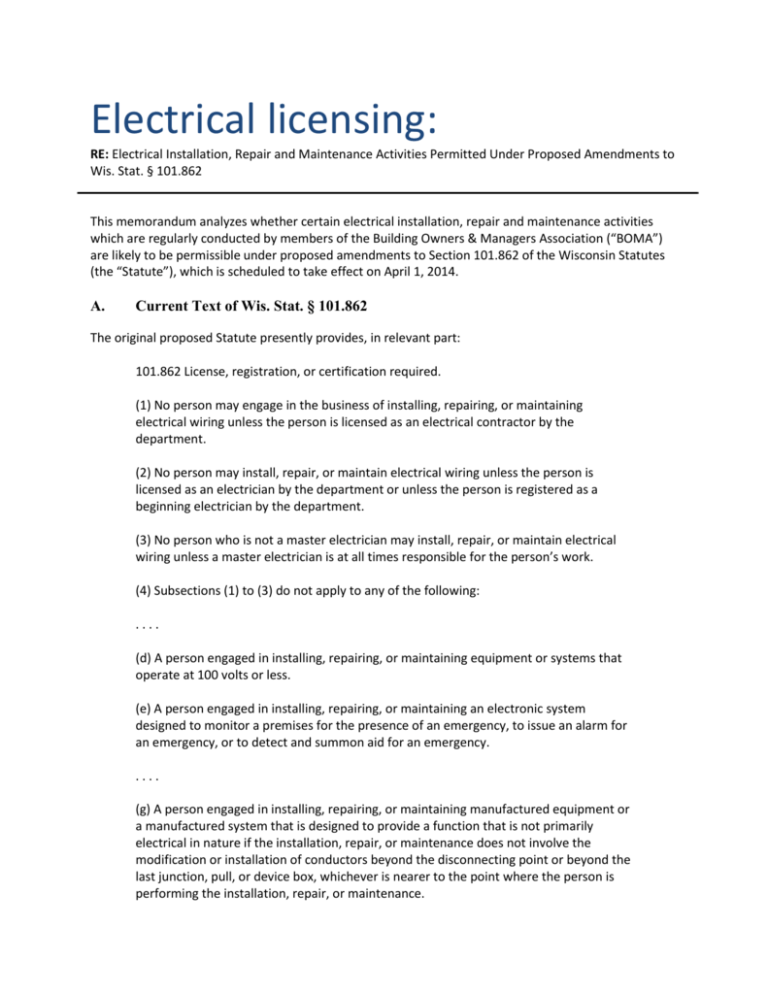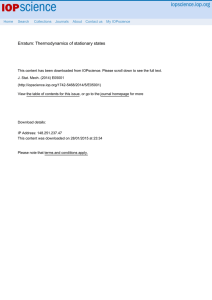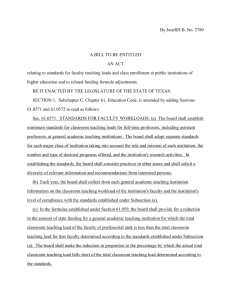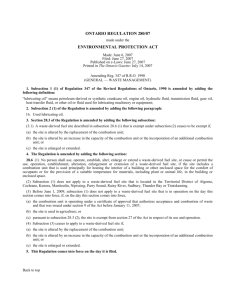Electrical licensing: RE: Electrical Installation, Repair and
advertisement

Electrical licensing: RE: Electrical Installation, Repair and Maintenance Activities Permitted Under Proposed Amendments to Wis. Stat. § 101.862 This memorandum analyzes whether certain electrical installation, repair and maintenance activities which are regularly conducted by members of the Building Owners & Managers Association (“BOMA”) are likely to be permissible under proposed amendments to Section 101.862 of the Wisconsin Statutes (the “Statute”), which is scheduled to take effect on April 1, 2014. A. Current Text of Wis. Stat. § 101.862 The original proposed Statute presently provides, in relevant part: 101.862 License, registration, or certification required. (1) No person may engage in the business of installing, repairing, or maintaining electrical wiring unless the person is licensed as an electrical contractor by the department. (2) No person may install, repair, or maintain electrical wiring unless the person is licensed as an electrician by the department or unless the person is registered as a beginning electrician by the department. (3) No person who is not a master electrician may install, repair, or maintain electrical wiring unless a master electrician is at all times responsible for the person’s work. (4) Subsections (1) to (3) do not apply to any of the following: .... (d) A person engaged in installing, repairing, or maintaining equipment or systems that operate at 100 volts or less. (e) A person engaged in installing, repairing, or maintaining an electronic system designed to monitor a premises for the presence of an emergency, to issue an alarm for an emergency, or to detect and summon aid for an emergency. .... (g) A person engaged in installing, repairing, or maintaining manufactured equipment or a manufactured system that is designed to provide a function that is not primarily electrical in nature if the installation, repair, or maintenance does not involve the modification or installation of conductors beyond the disconnecting point or beyond the last junction, pull, or device box, whichever is nearer to the point where the person is performing the installation, repair, or maintenance. .... B. Proposed Amendments to the Statute 1. Legislative Amendments The Wisconsin legislature is currently considering amendments to Wis. Stat. § 101.862 which would amend the Statute to provide an exception to the licensing requirement as follows: (Preliminary Draft, LRB 2698/P2.) 2. Proposed BOMA Amendments BOMA may propose addition of the phrase “replace[ing] existing outlets and switches” to the list of activities which are exempt under subsection 4(g) of the Statute. 3. Amendment for Employees Maintaining and Repairing Electrical Wiring The legislature is also considering amendments to subsection (4)(b) of the Statute, which is set forth below. This subsection provides a broad exemption to property owners who employ maintenance staff to perform electrical maintenance and repair. Notably, the exception under subsection (4)(b) does not contain the same limitations as proposed subsection (4)(g) in terms of the types of equipment covered by the exemption. Therefore, to the extent that BOMA members employ maintenance staff to maintain or repair electrical wiring on owned or leased properties, this exemption applies without the need to perform the analysis required to invoke the exception under proposed subsection (4)(g). C. Definitions of Key Statutory Terms The Wisconsin Administrative Code defines electrical wiring as follows: “Electrical wiring” means all equipment, wiring, material, fittings, devices, appliances, fixtures and apparatus used for the production, modification, regulation, control, distribution, utilization or safeguarding of electrical energy for mechanical, chemical, cosmetic, heating, lighting or similar purposes as covered by the scope of this chapter. (SPS 316.915(6)). Wisconsin has adopted the National Electrical Code, NEC-2008. See SPS 316.014, et seq. The NEC defines several terms which are used in the Statute and which control the analysis of whether certain activities are exempt under the Statute: Branch Circuit. The circuit conductors between the final overcurrent device protecting the circuit and the outlet(s). Equipment. A general term including material, fittings, devices, appliances, luminaires (fixtures), apparatus, machinery and the like used as a part of, or in connection with, an electrical installation. Luminaire. A complete lighting unit consisting of a light source such as a lamp or lamps, together with the parts designed to position the light source and connect it to the power supply. It may also include parts to protect the light source or the ballast or to distribute the light. A lamp holder itself is not a luminaire. Outlet. A point on the wiring system at which current is taken to supply utilization equipment. Switch, General-Use Snap. A form of general-use switch constructed so that it can be installed in device boxes or on box covers, or otherwise used in conjunction with wiring systems recognized by this Code. Utilization Equipment. Equipment that utilizes electric energy for electronic, electromechanical, chemical, heating, lighting, or similar purposes. (National Electrical Code, 2008 ed., Art. 100 – Definitions.) D. Analysis of Electrical Installation, Repair and Maintenance Activities Various regularly-conducted electrical installation, repair and maintenance activities are identified below that you requested we review. The portion(s) of the Statute (as amended) which would apply to each activity are also identified. 1. 2. 3. Installing a cord on a new stove. (New stoves do not come with a cord attached because they can be 3 or 4 pronged. The cord is purchased separately and installed onsite.) Covered by exemption for utilization equipment under proposed subsection (4)(g). Installing a cord on a new electric dryer. (New electric dryers do not come with a cord attached because they can be 3 or 4 pronged.) Covered by exemption for utilization equipment under proposed subsection (4)(g). Replacing a light switch. Covered under the proposed exemption for replacing existing switches. This activity may also be covered under the exception for utilization equipment. The definition of utilization equipment includes “equipment which utilizes electric energy for . . . lighting.” Equipment is defined as “material, fittings, devices . . . apparatus, and the like used as a part of, or in connection with, an electrical installation.” The replacement of a light switch does not involve modification or installation of branch circuit conductors that are external to the utilization equipment (the switch). The switch is attached using wire screws, and no modification of the wiring within the branch circuit conductors (defined as the conductors between the final overcurrent device, e.g., circuit breaker, and the outlet). However, the light switch could be considered to “provide a function that is . . . primarily electrical nature” and, therefore, not fall within the exemption. See proposed subsection (4)(g). Therefore, it would be preferable to include the specific exemption for replacing existing switches in the Statute. 4. Replacing an outlet. Covered under the proposed exemption for replacing existing outlets. This activity does not appear to be covered under the exemptions in proposed subsection (4)(g), however, because the outlets “provide a function that is . . . primarily electrical in nature.” Therefore, it would be preferable to include the specific exemption for replacing existing outlets in the Statute. 5. 6. 7. 8. 9. Replacing a range hood over a stove. Covered by exemption for utilization equipment under proposed subsection (4)(g). Replacing light fixtures in an apartment. Covered by exemption for utilization equipment – luminaires under proposed subsection (4)(g). Replacing ballast for fluorescent light fixtures. Covered by exemption for utilization equipment – ballasts under proposed subsection (4)(g). Replacing a fan or defrost heater inside of a refrigerator. Covered by exemptions for manufactured equipment and utilization equipment under proposed subsection (4)(g). Replacement of a bad circuit breaker or GFI’s (Ground fault circuit interrupters). The exception in proposed subsection (4)(g) most likely does not apply to this activity because the circuit breakers and GFIs “provide a function that is . . . primarily electrical in nature.” However, the exception in subsection (4)(b), which applies to “a person engaged in maintaining or repairing electrical wiring . . . on premises owned or leased by the person or by an entity for which the person is an employee,” would cover this work if performed by employees of entity which owns or leases the property. 10. Replacement of a hard-wired smoke detector. Covered by exemption for utilization equipment under proposed subsection (4)(g) and exemption for emergency monitoring under subsection (4)(e). Standard hardwired smoke detectors are 110 volts, but low voltage exception for systems operating at 100 volts or less may apply under subsection (4)(d). 11. Replacement of a hard-wired carbon monoxide detector. Covered by exemption for utilization equipment under proposed subsection (4)(g), for emergency monitoring under subsection (4)(e), and possibly under low voltage exception for systems operating at 100 volts or less under subsection (4)(d). 12. Replacement of a fan control switch for a range hood or ceiling fan. Covered by exemptions for manufactured equipment and utilization equipment under proposed subsection (4)(g). 13. Replacement of a bathroom fan motor. Covered by exemptions for manufactured equipment and utilization equipment under proposed subsection (4)(g). 14. Replacement of a garbage disposal. (Garbage disposals are not corded when purchased and need to be hard wired or a service cord added after purchase.) Covered by exemptions for manufactured equipment and utilization equipment under proposed subsection (4)(g). 15. Replacement of a photocell control for a patio light. Covered by exemption for utilization equipment under proposed subsection (4)(g); for some units, low voltage exception for systems operating at 100 volts or less under subsection (4)(d). 16. Replacement of a dishwasher or certain parts of a dishwasher. Covered by exemptions for manufactured equipment and utilization equipment under proposed subsection (4)(g). 17. Replacement of electric baseboard heaters. Covered by exemptions for manufactured equipment and utilization equipment under proposed subsection (4)(g). 18. Replacement of line voltage thermostat for heaters. Covered by exemptions for manufactured equipment and utilization equipment under proposed subsection (4)(g) and certain models (24-30 volts) may fall within the low voltage exception for systems operating at 100 volts or less under subsection (4)(d). 19. Replacement of a garage door motor. 20. 21. 22. 23. 24. E. Covered by exemptions for manufactured equipment and utilization equipment under proposed subsection (4)(g). Replacement of a garage or attic exhaust fan motor. Covered by exemptions for manufactured equipment and utilization equipment under proposed subsection (4)(g). Replacement of emergency lighting fixtures. Covered by exemptions for electric signs and luminaires under proposed subsection (4)(g). Replacement of a transformer for: (a) doorbell system; (b) intercom system; (c) furnace; (d) video surveillance power supply; (e) alarm system. Covered by exemptions for manufactured equipment, utilization equipment, and manufactured system not electrical in nature under proposed subsection (4)(g); low voltage exception for systems operating at 100 volts or less under subsection (4)(d); emergency monitoring under subsection (4)(e). Replacement of a bad heating element or thermostat in an electric water heater. Covered by exemptions for manufactured equipment and utilization equipment under proposed subsection (4)(g). Replacement of circulating pump for hydronic (hot water) heating system. Covered by exemptions for manufactured equipment and utilization equipment under proposed subsection (4)(g). Conclusion The proposed exceptions significantly expand the scope of activities exempted from the Statute. As a result, the vast majority of routine electrical installation, maintenance and repair tasks performed by BOMA members would be exempt. The Statute, however, has not yet taken effect. There is no history of regulatory enforcement by the Wisconsin Department of Safety and Professional Services (“SPS”) or case law interpreting the Statute. Therefore, BOMA members should be aware that, as with any new law, particularly one that is part of a complex regulatory scheme, the actual experience of regulated businesses could be different than reasonably anticipated based on the plain language of the amended Statute.



